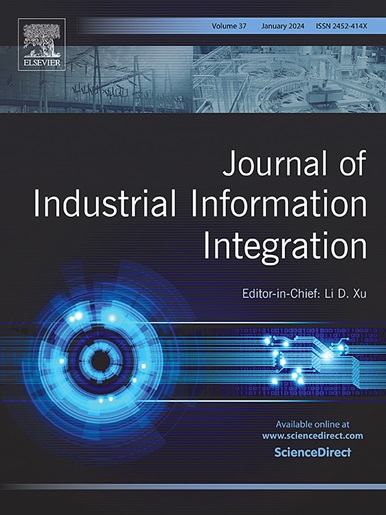An optimized learning approach for enhancing the security of digital twin-enabled industrial systems from distributed denial-of-service attacks
IF 10.4
1区 计算机科学
Q1 COMPUTER SCIENCE, INTERDISCIPLINARY APPLICATIONS
引用次数: 0
Abstract
During the revolution of Industry 4.0, digital twin technology is transforming industrial operations by creating digital models of physical assets, processes, and systems. This innovation enables real-time monitoring, predictive maintenance, and enhanced decision-making capabilities. However, as digital twins become integral to industrial environments, they also introduce new cybersecurity challenges, particularly in the form of distributed denial-of-service (DDoS) attacks, which can disrupt operations and compromise data integrity. This study investigates the resilience of digital twin-based industrial organizations in cyberattack scenarios, specifically focusing on the impacts of DDoS attacks on functional and financial performance. In this paper, a hybrid DDoS attack detection model is introduced, integrating multiple techniques for data preprocessing, feature selection, dimensionality reduction, and classification . To address the class imbalance issue,Synthetic Minority Over-sampling Technique (SMOTE) is applied during preprocessing. Feature selection is performed using filter-based methods, including Information Gain, Gain Ratio, ANOVA F-statistic, Pearson Correlation, and the technique for order preference by similarity to ideal solution (TOPSIS), a multi-criteria decision-making method. To enhance computational efficiency, principal component analysis (PCA) is used for dimensionality reduction, preserving critical information while reducing redundancy. For classification, an extreme learning machine (ELM) is optimized using the particle swarm optimization (PSO) algorithm, improving generalization, preventing overfitting, and ensuring faster convergence. The experiment is conducted using the publicly available CICDDoS2019 dataset in both standalone and cloud-based environments with configurations of vCPU-4, vCPU-8, and vCPU-16. Additionally, a 5-fold stratified cross-validation approach is employed to enhance the model’s generalization performance and ensure robustness across different data distributions. The experimental results indicate that the proposed model achieves a 99.97% detection accuracy and an AUC score of 0.99 in the cloud environment with vCPU-16 and 64GB RAM, outperforming traditional algorithms in DDoS detection. The experimental study finds that increased computational resources improve performance, indicating the model’s adaptability. As digital twins rely on seamless physical-virtual communication, DDoS attacks threaten synchronization, latency, and reliability. The proposed detection approach enhances resilience, minimizes downtime, and preserves process integrity, contributing to secure and robust digital twin architectures in Industry 4.0.
一种优化的学习方法,用于增强数字孪生工业系统免受分布式拒绝服务攻击的安全性
在工业4.0革命期间,数字孪生技术正在通过创建物理资产、流程和系统的数字模型来改变工业运营。这一创新实现了实时监控、预测性维护和增强的决策能力。然而,随着数字孪生成为工业环境不可或缺的一部分,它们也带来了新的网络安全挑战,特别是以分布式拒绝服务(DDoS)攻击的形式,这会破坏运营并损害数据完整性。本研究调查了基于数字孪生的工业组织在网络攻击场景下的弹性,特别关注DDoS攻击对功能和财务绩效的影响。本文介绍了一种混合DDoS攻击检测模型,该模型集成了数据预处理、特征选择、降维和分类等多种技术。为了解决类不平衡问题,在预处理过程中采用了合成少数派过采样技术(SMOTE)。特征选择使用基于过滤器的方法进行,包括信息增益,增益比,方差分析f统计量,Pearson相关,以及通过与理想解决方案相似的顺序偏好技术(TOPSIS),这是一种多标准决策方法。为了提高计算效率,采用主成分分析(PCA)进行降维,在减少冗余的同时保留关键信息。对于分类,使用粒子群优化(PSO)算法对极限学习机(ELM)进行优化,提高了泛化程度,防止了过拟合,保证了更快的收敛速度。实验使用公开的CICDDoS2019数据集在独立和基于云的环境下进行,配置为vCPU-4, vCPU-8和vCPU-16。此外,采用5倍分层交叉验证方法来提高模型的泛化性能,并确保跨不同数据分布的鲁棒性。实验结果表明,该模型在vCPU-16、内存为64GB的云环境下,检测准确率达到99.97%,AUC分数为0.99,优于传统的DDoS检测算法。实验研究发现,计算资源的增加提高了性能,表明了模型的适应性。由于数字孪生依赖于无缝的物理-虚拟通信,DDoS攻击威胁到同步、延迟和可靠性。所提出的检测方法增强了弹性,最大限度地减少了停机时间,并保持了过程完整性,有助于在工业4.0中实现安全可靠的数字孪生架构。
本文章由计算机程序翻译,如有差异,请以英文原文为准。
求助全文
约1分钟内获得全文
求助全文
来源期刊

Journal of Industrial Information Integration
Decision Sciences-Information Systems and Management
CiteScore
22.30
自引率
13.40%
发文量
100
期刊介绍:
The Journal of Industrial Information Integration focuses on the industry's transition towards industrial integration and informatization, covering not only hardware and software but also information integration. It serves as a platform for promoting advances in industrial information integration, addressing challenges, issues, and solutions in an interdisciplinary forum for researchers, practitioners, and policy makers.
The Journal of Industrial Information Integration welcomes papers on foundational, technical, and practical aspects of industrial information integration, emphasizing the complex and cross-disciplinary topics that arise in industrial integration. Techniques from mathematical science, computer science, computer engineering, electrical and electronic engineering, manufacturing engineering, and engineering management are crucial in this context.
 求助内容:
求助内容: 应助结果提醒方式:
应助结果提醒方式:


